
Basics, Foundation, Learning, programing, REST API
Introduction: In modern web development, Application Programming Interfaces (APIs) have become essential for enabling seamless communication between different software systems. Representational State Transfer (REST) API, in particular, has emerged as a widely adopted architectural style for designing and implementing web services. This article aims to shed light on the fundamentals of REST API, its benefits, and its significance in today’s digital landscape.
Understanding REST API: REST API is an architectural style defining constraints for building networked systems. It is based on the principles of simplicity, scalability, and interoperability. REST leverages the existing infrastructure of the World Wide Web and uses a stateless, client-server communication model.
Critical Principles of REST API:
- Stateless Communication: Each request from a client to a server is independent and self-contained, containing all the necessary information to process the request. The server does not maintain any client-specific context between requests.
- Uniform Interface: REST API employs a standardized set of operations, such as HTTP methods (GET, POST, PUT, DELETE), to perform actions on resources. It also uses standard data formats for data exchange, like JSON or XML.
- Resource-Based: REST API treats every system component as a resource, identified by a unique Uniform Resource Identifier (URI). These resources can be accessed and manipulated using standard HTTP verbs.
- Hypermedia as the Engine of Application State (HATEOAS): REST API includes hyperlinks in the responses, enabling clients to dynamically navigate and discover available resources.
Benefits of REST API:
- Simplified Integration: REST API provides a straightforward and intuitive way to integrate different applications, platforms, and services. Its reliance on widely supported standards, such as HTTP and JSON, makes it accessible to developers across various programming languages.
- Scalability and Performance: REST’s stateless nature and utilization of the HTTP protocol’s caching capabilities contribute to improved scalability and performance. It allows for easy scaling of server resources and reduces the overhead associated with maintaining client session information.
- Platform Independence: REST API is platform-independent, meaning it can be consumed by any device or application that can request HTTP. This flexibility is crucial in today’s multi-device, multi-channel digital landscape.
- Encourages Loose Coupling: REST API promotes loose coupling between client and server components. Separating concerns allows both sides to evolve independently, enhancing system flexibility and maintainability.
- Wide Industry Adoption: REST API has gained significant popularity due to its simplicity, making it the de facto standard for building web services. Its extensive use in major cloud platforms and numerous open-source frameworks further solidifies its importance.
Conclusion: REST API has revolutionized how applications communicate, providing a powerful and flexible approach for integrating systems in a standardized manner. With its emphasis on simplicity, scalability, and platform independence, REST has become the go-to choice for developers and organizations seeking efficient and reliable interconnectivity. Understanding the principles and benefits of REST API opens up a world of possibilities for creating interconnected digital ecosystems and driving innovation in the rapidly evolving technology landscape.

Personal Blog, Technology |
The Rise of Streaming Services
Streaming services have become an integral part of our lives in recent years. With technological advancements and the increasing popularity of on-demand entertainment, traditional cable and satellite TV providers face tough competition from streaming platforms.
It all started with the introduction of Netflix in 2007, revolutionizing media consumption. Netflix allows users to stream movies and TV shows directly to their devices without the need for physical media or scheduled programming. This shift in the entertainment industry gave birth to a new era of streaming services.
The Streaming Wars Begin
As the popularity of streaming services grew, more companies jumped on the bandwagon. Amazon Prime Video, Hulu, and Disney+ entered the market, offering unique content libraries and features.
The competition intensified when Apple launched Apple TV+ and HBO Max joined the streaming wars. With so many streaming services, consumers were spoilt for choice, and the battle for subscribers began.
Content is King
In the streaming wars, content became the driving force behind the success of each platform. Exclusive shows and movies became the highlights, with platforms investing heavily in original programming to attract subscribers.
Netflix set the trend with critically acclaimed shows like Stranger Things and House of Cards. Amazon Prime Video followed suit with hit series such as The Marvelous Mrs. Maisel and The Boys. Disney+ capitalized on its extensive content catalog, including the Marvel Cinematic Universe and Star Wars franchises.
Not to be left behind, Hulu produced award-winning shows like The Handmaid’s Tale and Little Fires Everywhere. HBO Max brought its iconic HBO series and added new originals like Lovecraft Country and The Flight Attendant.
The Fragmented Streaming Landscape
With the increasing number of streaming services, the industry became fragmented. Consumers now had to subscribe to multiple platforms to access their favorite shows and movies.
This fragmentation led to the rise of bundled streaming services. Companies like Roku and Amazon Fire TV offered streaming devices that allowed users to access multiple platforms through a single interface. Streaming media also started bundling their services to provide a more comprehensive offering.
The Future of Streaming
The streaming wars show no signs of slowing down. New players like Paramount+ and Peacock have entered the market while existing platforms continue to invest in original content.
The future of streaming is likely to be a combination of exclusive content, bundled offerings, and personalized recommendations. We can expect better streaming quality, enhanced user interfaces, and more immersive viewing experiences as technology advances.
The Conclusion
The evolution of streaming services has transformed the way we consume entertainment. From the early days of Netflix to the current streaming wars, the industry has come a long way. With an ever-growing number of platforms and abundant content, consumers now have more choices.
As the streaming landscape continues evolving, platforms must differentiate themselves through unique content and user-friendly features. Ultimately, the consumers benefit from the fierce competition, as they have access to a wide range of high-quality entertainment options at their fingertips.

Personal Blog, Personal Development |
Success is a cherished goal for many, an elusive dream that often seems just out of reach. It’s a notion that captures the imagination and inspires individuals to push their limits, overcome challenges, and reach their fullest potential. While success may be defined differently by different people, one common theme that often emerges is the importance of starting the day early. The idea that waking up in the morning can be a catalyst for success has been a recurring theme in self-improvement literature, motivational speeches, and the lives of countless high achievers. But is there any substance to this notion, or is it merely a myth?
The Power of Morning Routines
The notion of morning routines, particularly those that begin early in the day, has gained significant attention in recent years. Successful individuals attribute some of their achievements to the habits they cultivate in the morning. While the specific activities in these routines may vary widely, the underlying principle remains the same: starting the day with intention and purpose can set a positive tone for the hours ahead.
Consider the following aspects of morning routines that can contribute to success:
1. Consistency: Successful people often thrive on consistency. A set morning routine provides a stable foundation for the day, helping individuals stay on track and focus on their goals.
2. Time Management: The early morning hours can be remarkably productive. With fewer distractions, individuals can make the most of this time to tackle important tasks, plan their day, or engage in self-improvement activities.
3. Mindset: Your mental state upon waking can significantly impact your day. Starting the morning with a positive mindset can boost confidence, enhance problem-solving abilities, and provide resilience when facing challenges.
4. Goal Setting: Achieving success is often a result of setting clear goals and priorities. The early hours of the day provide a tranquil environment for reflection and strategic planning.
5. Productivity: Many people are most productive in the morning. By capitalizing on this natural rhythm, individuals can accomplish more in less time, contributing to their success.
Success Beyond the Morning
While a morning routine can be a powerful tool in pursuing success, it’s essential to understand that success encompasses various aspects of life. Achieving success is not limited to professional accomplishments or career milestones; it extends to personal fulfillment, happiness, and well-being.
Here are some key points to consider when thinking about success:
1. Work-Life Balance: Success should not come at the expense of work-life balance. True success involves finding harmony between your professional and personal life, allowing you to enjoy career achievements and quality time with loved ones.
2. Personal Growth: Success is an ongoing personal growth and self-discovery journey. It involves continually learning, adapting, and evolving to become the best version of yourself.
3. Passion and Purpose: Finding what you are passionate about and aligning your actions with your purpose can significantly drive success. Pursuing your passions can lead to a more fulfilling and rewarding life.
4. Resilience: Success is often accompanied by setbacks and challenges. Developing resilience is crucial in overcoming obstacles and maintaining the drive to achieve your goals.
5. Health and Well-being: A successful life includes caring for your physical and mental health. Prioritizing self-care, exercise, and a balanced diet can contribute to your overall well-being and, in turn, your success.
6. Individual Differences: It’s important to acknowledge that people have unique circadian rhythms and preferences. What works for one person may not work for another. Some individuals naturally tend to be early risers, while others thrive in the evening.
In conclusion, waking up early and pursuing a well-thought-out morning routine can be valuable to a successful life. However, success is a multi-faceted concept that extends far beyond the early hours of the day. It involves many factors, including hard work, dedication, effective planning, and a positive mindset. Success is a deeply personal journey, and each individual’s path to achieving it may differ.
Ultimately, the key to success lies in finding a routine and lifestyle that aligns with your unique goals, values, and aspirations. While early mornings can be a powerful tool, success can be attained at any time of the day as long as you remain committed to your dreams and consistently take action to pursue them. So, whether you’re an early bird or a night owl, remember that success is within your grasp, waiting for you to seize it with determination and purpose.

programing, Web Design
JavaScript is a powerful programming language that is crucial in modern website design. It helps developers create dynamic and interactive web pages that engage users and provide an enhanced browsing experience. With its wide range of capabilities, JavaScript has become an essential tool for web designers across the globe.
One of the key advantages of using JavaScript in website designing is its ability to add interactivity. By incorporating JavaScript code into web pages, designers can create interactive elements such as image sliders, drop-down menus, and forms that respond to user actions. This interactivity improves user engagement and makes the website more user-friendly and intuitive.
Another important aspect of JavaScript in website designing is its capability to manipulate the Document Object Model (DOM). The DOM is a programming interface that represents the structure of an HTML document. JavaScript can modify the DOM elements, such as adding or removing content, changing styles, or animating elements. This allows designers to dynamically update the website’s content and appearance without reloading the entire page.
JavaScript also enables designers to implement client-side form validation. With JavaScript, designers can validate user input in real-time without server-side validation. This helps provide users instant feedback, preventing them from submitting incorrect or incomplete data. Additionally, JavaScript can enhance the user experience by displaying error messages or highlighting wrong fields, further improving the website’s usability.
Furthermore, JavaScript offers powerful APIs (Application Programming Interfaces) that allow designers to integrate various third-party services and functionalities into their websites. For example, designers can use JavaScript APIs to integrate social media sharing buttons, embed maps, create charts, or implement video players. These APIs provide a seamless integration of external services, enhancing the website’s functionality and enriching the user experience.
JavaScript also plays a significant role in optimizing website performance. By utilizing JavaScript techniques such as asynchronous loading, lazy loading, and minification, designers can reduce the website’s loading time, resulting in faster and more efficient browsing. JavaScript frameworks like React and AngularJS enhance website performance by providing efficient rendering and state management capabilities.
In conclusion, JavaScript is an indispensable tool for website design. Its ability to add interactivity, manipulate the DOM, validate form inputs, integrate third-party services, and optimize performance makes it a crucial component of modern web design. By leveraging the power of JavaScript, designers can create dynamic, user-friendly, and visually appealing websites that leave a lasting impression on visitors.

Guitar, Music
Introduction
Nothing Else Matters by Metallica is a timeless classic that has captivated guitar enthusiasts for decades. The haunting melody, heartfelt lyrics, and intricate guitar work make it a must-learn song for any aspiring guitarist. In this comprehensive guide, we will delve into the world of Nothing Else Matters guitar chords, exploring the various chord progressions and techniques used in this iconic track.
Chords Used
Before we dive into the specific chord progressions, let’s take a look at the chords used in Nothing Else Matters:
The song primarily revolves around these five chords, adding variations and embellishments to create depth and texture.
Verse Chord Progression
The verse chord progression in Nothing Else Matters follows a simple pattern:
[Em] [G] [Em] [G] [C] [D] ...
Try experimenting with different strumming patterns and arpeggios to add some flair to your playing. This will help you capture the emotion and intensity of the song.
Pre-Chorus Chord Progression
The pre-chorus section introduces a slight variation in the chord progression:
[C] [D] [Am] [C] [D] ...
Focus on smoothly transitioning between these chords to maintain the flow and continuity of the song.
Chorus Chord Progression
The chorus of Nothing Else Matters brings a sense of resolution and power. The chord progression for the chorus is as follows:
[Em] [G] [D] [C] [Em] [G] [D] [C] [D] ...
Pay attention to your playing dynamics during the chorus, emphasizing the powerful strums and allowing the chords to ring out.
Bridge and Solo
The bridge and solo sections of Nothing Else Matters showcase the guitar mastery of Metallica’s lead guitarist, Kirk Hammett. These sections feature melodic lines and intricate guitar solos that add a touch of brilliance to the song.
Conclusion
Guitar chords of Nothing Else Matters will allow you to play this iconic song and enhance your overall guitar-playing skills. Remember to practice with a metronome, focus on clean chord changes, and experiment with different strumming patterns. With dedication and perseverance, you will be able to capture the essence of this beautiful song.





